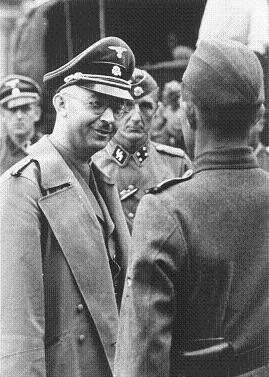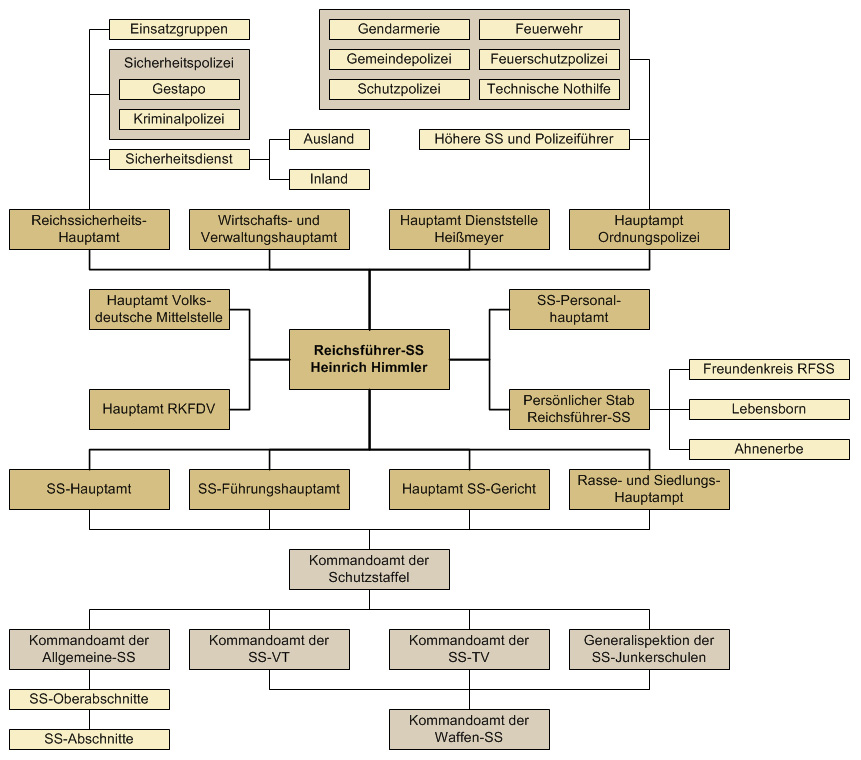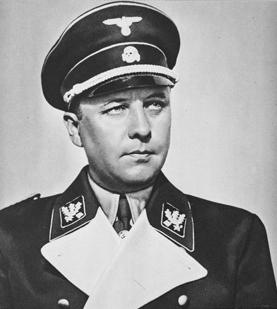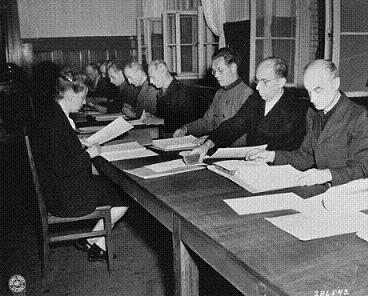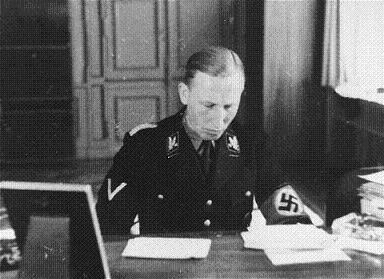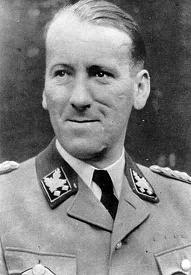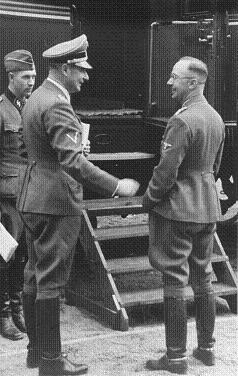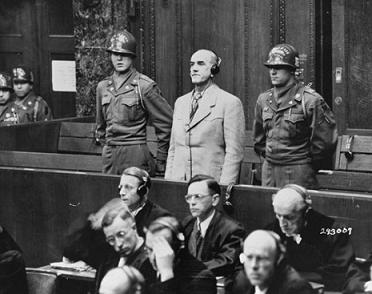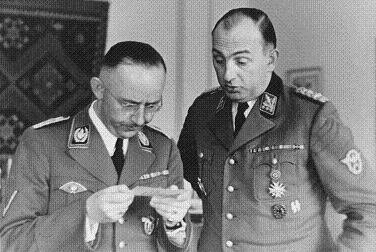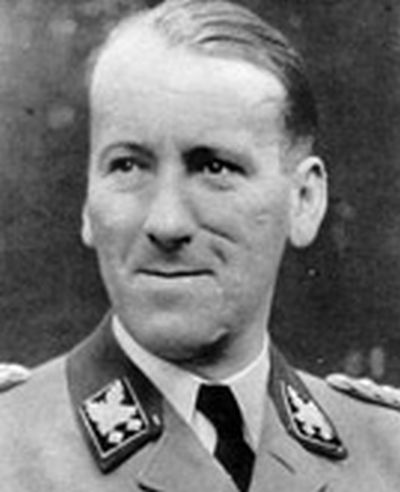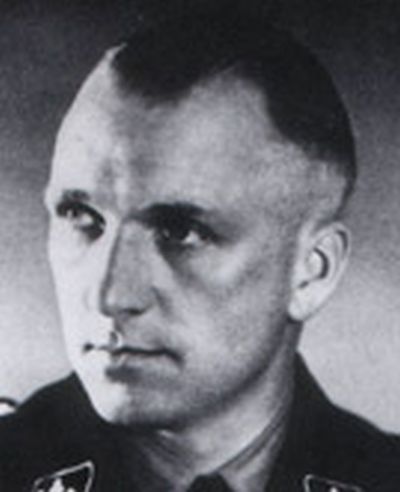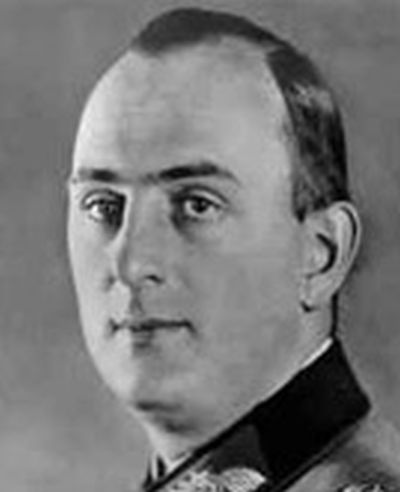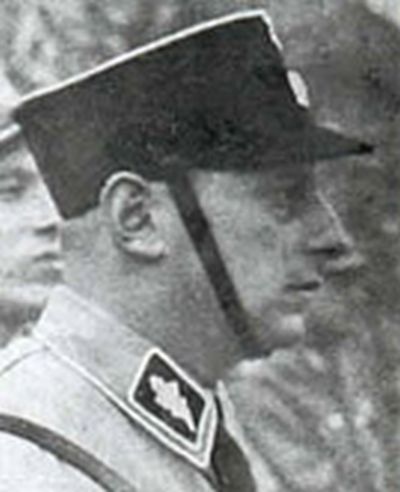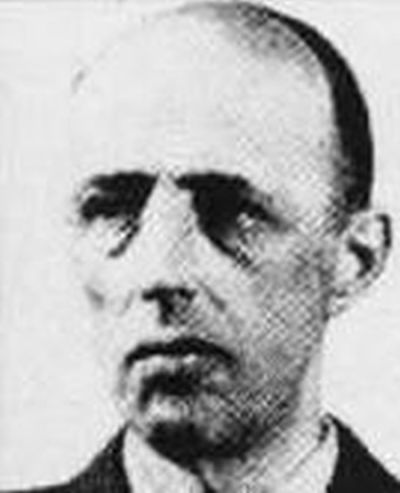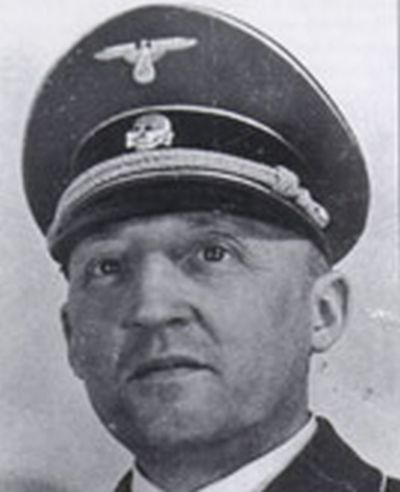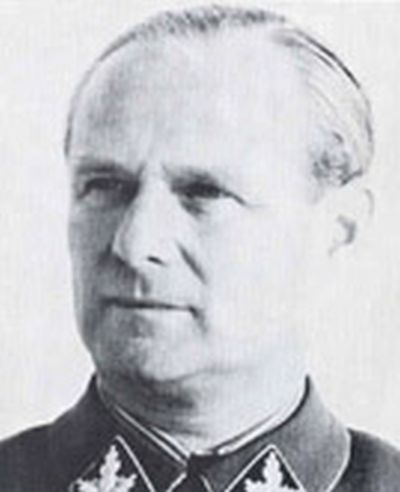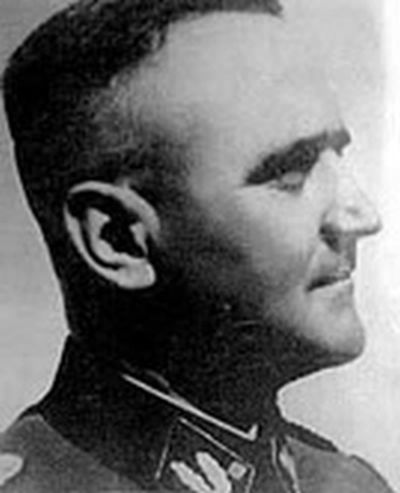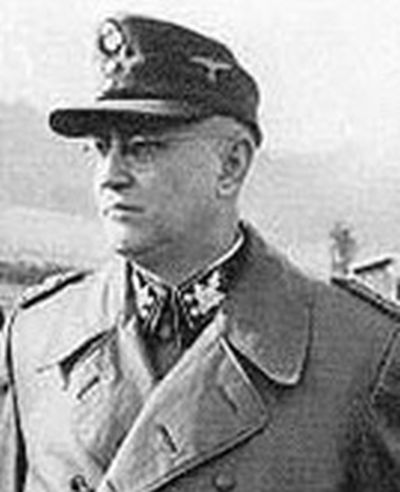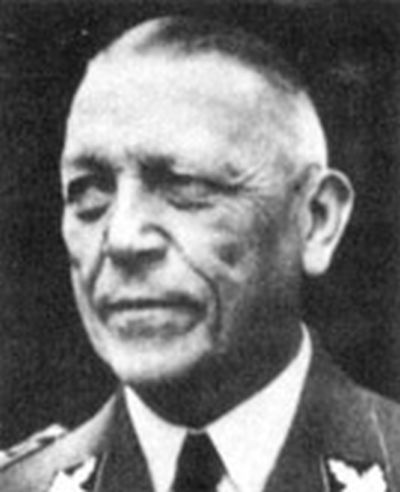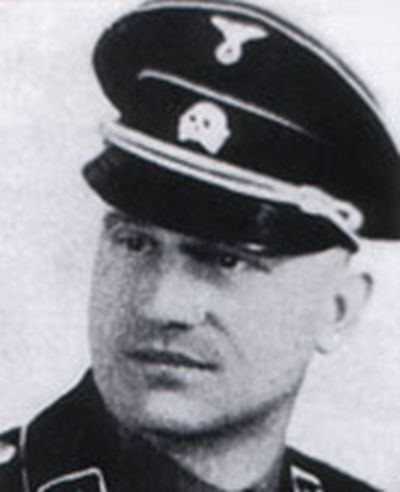From SS-Amt to Reichsführung-SS
At the pinnacle of its power, the Schutzstaffel or SS was directed from 12 so-called Hauptämter or main offices which together made up the Reichsführung-SS. These main offices were divided in Amtsgruppen and Ämter which were themselves divided in subordinate offices. The foundation of this structure found its roots in the structure of the Sturmabteiling or SA , the SS being a part thereof until the 'Night of the Long Knives' in June 1934. The SA leadership was formally in charge of the SS but also saw to the recruitment of men from the SA for the SS. At the time, the SS was directly subordinate to the Oberste SA-Führung, the command center of the SA headed by the Oberste SA-Führer. From 1926 to 1930 this position was held by the former leader of a Freikorps Felix Pfeiffer von Salomon. In 1930 this function was renamed Chef des Stabes. Ernst Röhm, former officer of the Reichswehr and personal friend of Adolf Hitler held this post from 1931 to 1934. Both he and Von Salomon created an organizational structure which became the foundation for the one of the SS.
In 1929 Heinrich Himmler was put in charge of the SS. At the time he commanded less than 300 men and control over the SS was still rather straightforward. Himmler created a vast number of executive levels though and exaggerated the number of men under his command. This exaggeration of power levels and numbers of men would be one of his characteristic methods of work during his tenure. He established the SS-Amt as executive organ of the SS and experimented with various offices within this supreme command. During the existence of the SS, these (main) offices regularly changed names, form and function. Himmler himself took supreme command of the SS-Amt but operational direction was in the hands of the following officers:
- Dr Ernst Bach from December 1932 until June 12, 1933.
- Siegfried Seidel-Dittmarsch from June 12, 1933 until February 1, 1934.
- Kurt Wittje from February 1, 1934 until January 30, 1935.
In the early years of the SS, Himmler created the SS-Oberstab but this organization was disbanded after a short time. During the early 30s, he also experimented with a liaison office which was to coordinate the communication between the SS and other departments of the NSDAP. This office was known as the Führungsstab and was headed by his former adjutant Siegfried Seidel-Dittmarsch. When he passed away, it also meant the end of this Stab. A somewhat similar liaison office was the Gruppenstab z.b.V or staff with special duties which was to exchange information between the SS and government and NSDAP departments but this office disappeared in the summer of 1935 as well.

Cuff links and rank distinction signs of the various SS units. Source: Organisationshandbuch der NSDAP (1939)
Two offices which already existed before the RF-SS was established with its 12 offices and eventually merged with it were the Rasse und Siedlung Hauptamt, RuSHA or main office of race and settlement and the Ic Dienst or intelligence branch. The RuSHA became one of the twelve main offices and the IcD became part of one of the main offices. It goes without saying that Himmler, being Reichsführer-SS, was in command of all main offices. The offices themselves were headed by a chief of chief of staff, usually holding the rank of SS-Obergruppenführer or SS-Oberstgruppenführer. These men held ranks in the Allgemeine-SS but in most cases held ranks within the German police, Waffen-SS or another branch of the Gesammt-SS as well. Various main offices not only bore certain responsibilities within the SS but also within the police. Apart from being RF-SS, Himmler was also Chief of the German police as from June 1936. From that date on, the organizational structure of the SS and the German police were closely connected.
Definitielijst
- Freikorps
- German paramilitary units established directly after the Great War by former front soldiers. These groups were often named after their commander. Freikorps formed the basis of the eventual SA or Sturmabteilung.
- Night of the Long Knives
- Night of 30 June to 1 July 1933 during which Hitler killed many of the demanding leaders of the SA, including Ernst Röhm.
- Reichswehr
- German army during the Weimar republic.
- Waffen-SS
- Name of Military section of the SS.
SS-Hauptamt and Rasse- und Siedlungshauptamt
In the years prior to the war, the SS-HA was the major command center of the SS. During the war, this office mainly occupied itself with general policy and personnel issues. The following persons were subsequently in daily charge of the SS-HA:
- SS-Gruppenführer Kurt Wittje from January 30 to May 22 1935,
- SS-Obergruppenführer August Heißmeyer from May 22 1935 to April 1, 1940,
- SS-Obergruppenführer Gottlob Berger from 1940 to 1945.
SS-Hauptamt
When the SS-HA was established on January 1935, it took over the majority of the power and tasks of the original SS-Amt. The SS-HA occupied itself with all tasks and elements within the SS except racial and security issues. At that time it was tasked with command of the SS, administration, personnel issues and jurisdiction. In addition, this office was responsible for the Allgemeine-SS, concentration camps, Politische Bereitschaften, a unit protecting Himmler and other Nazi leaders which evolved into the SS-Verfügungstruppe and subsequently the Waffen-SS and border guards. Later on, elements within the SS-HA would be tasked with physical training, well-being and supply. The SS-Officers School, communication services and SS garrisons were part of this main office.
After the outbreak of war, other main offices were established took over and various tasks from the SS-HA. The most important task of the SS-HA was the recruitment of men and of course, this was one of the main tasks within the entire SS. The office was involved for instance in the recruitment of volunteers for the Waffen-SS from various countries outside Germany. When the Waffen-SS suffered heavy losses in the last years of the war, many foreign volunteers supplemented these units. This main office was also tasked with issues in connection with physical training and 'Aryan' education of men.
Rasse un Siedlungshaupamt (RuSHA)
Racial purity of the men was a major issue within the SS and this was the main task of this office. The leaders of his office were:
- SS-Obergruppenführer Walter Darré from January 30, 1935 to September 11, 1938
- SS-Brigadeführer Günther Pancke from September 11, 1939 to July 9, 1940
- SS-Gruppenführer Otto Hofmann from July 9, 1940 to April 20, 1943
- SS-Obergruppenführer Richard Hildebrandt from April 20, 1943 to December 1943
- SS-Gruppenführer Dr. Harald Turner from December 25, 1943 to 1944
- SS-Obergruppenführer Richard Hildebrandt from 1944 to July 31, 1944)
- SS-Standartenführer Albert Uhlih from July 31, 1944 to 1944
- SS-Obergruppenführer Richard Hildebrandt from 1944 to 1945
This main office was developed in 1935 from the office with the similarly named office which existed since 1931. Its major task was the examination of recruits according to the strict, almost obsessive standards within the SS which prevailed in the years before the war. The main requirement for the men was they should be of pure Aryan descent without for instance Jewish or Slavic ancestry. During the war, these rules were drastically relaxed in order to supplement the huge losses at the front. The 13. Waffen-Gebirgs-Division der SS 'Handschar' was mainly made up of Croatian Muslims.
Apart from the ancestry of the man, the future wives of SS men were subjected to a genealogical examination as well. According to an internal memo from December 1930, SS men were obliged to obtain permission from the RF-SS to marry. Before this permission was granted, the RuSHA was to verify the racial purity of the future bride. Furthermore, this office advised on racial issues and held special training courses on the subject.
Definitielijst
- Nazi
- Abbreviation of a national socialist.
- Waffen-SS
- Name of Military section of the SS.
Reichssicherheitshauptamt
This office was the most powerful and feared main office within the SS. The RSHA occupied itself with security issues and was the umbrella organization for various (secret) police and intelligence organizations. The following persons were in charge of this office:
- SS-Obergruppenführer Reinhard Heydrich from 27 September 1939 to May 27, 1942)
- Reichsführer-SS Heinrich Himmler from May 1942 to January 1943
- SS-Obergruppenführer Ernst Kaltenbrunner from January 31, 1943 to May 8, 1945
The RSHA was established on September 27, 1939 from two existing main offices: the Hauptamt Sicherheitspolizei and the Sicherheits Hauptamt. Both offices were already headed by the Chef der Sicherheitspolizei und der Sicherheitsdienst Reinhard Heydrich. He was the first head of the RSHA but his tenure ended on June 4, 1942 when he succumbed to the injuries he had sustained after an attack by Czech resistance fighters in Prague. By merging the Sicherheitspolizei and the Sicherheitsdienst (SD) within the RSHA during his tenure, Heydrich created an extremely influential and feared organization which played an enormously important role within the Nazi terror apparatus.
The Sicherheitspolizei or SIPO consisted of the Gestapo (Geheime Staatspolizei) or secret state police) and the Kriminalpolizei or KRIPO (criminal investigation); both governmental departments which already existed before Adolf Hitler took power. The SD however was established as late as March 1934 and was a party organization responsible for gathering information beneficial to the security of the NSDAP and its members. It grew into the most important intelligence service which mainly occupied itself with tracking down political and racial enemies of the Third Reich in cooperation with the Gestapo. Within the RSHA, these offices were not only responsible for the arrest of Jews and other 'enemies' of the Reich but also for their deportation to concentration and extermination camps. Within the Jewish section of the Gestapo (Referat IVb) Adolf Eichmann and others occupied themselves with the organization of the extermination of European Jewry. Hence, the RSHA must be considered the organization which shaped the Holocaust.
In 1941, the RSHA consisted of these seven offices:
- AMT I Personal Organisation
- AMT II Verwaltung
- AMT III Sicherheitsdienst Inland (Deutsche Lebensgebiete)
- AMT IV Gestapo
- AMT V Reichskriminalpolizeiamt (RKPA)
- AMT VI Sicherheitsdienst Ausland (Auslandsnachrichtendienst)
- AMT VII Weltanschauliche Forschung und Auswertung Archiv
AMT I saw to the daily running of the RSHA and personnel affairs whereas AMT II took care of the administration. AMT III was responsible for the SD within the German Empire and AMT VI for the SD abroad. AMT VII saw to for instance investigation into various population groups including Jews, Marxists, Free Masonry and in addition kept the archives and library of the RSHA up to date. The Gestapo was organized within AMT IV and the KRIPO in AMT V. all of these departments were divided in various subdepartments which in turn were split in numerous branches, resulting in an extremely complex and all-encompassing organization.
An important component of the RSHA that should not be left unmentioned were the Einsatzgruppen. During the invasion of Poland and the Soviet Union, Heydrich established so-called Einsatzgruppen mainly from the various branches of the RSHA. These were tasked with the elimination of racial and political enemies behind the front. In Poland, they specifically targeted the intelligentsia and Jews with important positions but in the Soviet Union, they went far beyond that. The mass murder of (Jewish) civilians in the Soviet Union heralded the beginning of the organized extermination of European Jewry.
Definitielijst
- Gestapo
- “Geheime Staatspolizei”. Secret state police, the secret police in the Third Reich.
- Holocaust
- Term for the destruction of European Jewry by the Nazis. Holokauston is the Greek term for a completely burnt sacrifice.
- invasion
- Armed incursion.
- Jews
- Middle Eastern people with own religion that lived in Palestine. They distinguished themselves by their strong monotheism and the strict observance of the Law and tradition. During World War 2 the Jewish people were ruthlessly persecuted and annihilated by the German Nazis. . An estimated 6,000,000 Jews were exterminated.
- KRIPO
- Kriminalpolizei. Criminal investigation agency. Ordinary civilian police of Nazi Germany.
- Nazi
- Abbreviation of a national socialist.
- resistance
- Resistance against the enemy. Often also with armed resources.
- RSHA
- Reichssicherheitshauptamt. The central information and security service of the Third Reich.
- Sicherheitsdienst (SD)
- The national socialistic intelligence and counterespionage service of the SS.
- SIPO
- ”Sicherheitspolizei”. Combination (since 1936) of the Gestapo and criminal police.
- Soviet Union
- Soviet Russia, alternative name for the USSR.
Persönlicher Stab Reichsführer-SS
Himmler's personal staff occupied itself for instance with various tasks in connection with his direct work area. Advisors, adjutants and secretaries were employed in this main office. Throughout its existence, there were one leader: SS-Obergruppenführer Karl Wolff who held this function from June 8, 1936 unit February 1943. After that, Himmler himself took charge.
Himmler's personal staff existed well before the similarly named main office was established. The original staff and the eventual main office had two tasks. First, the staff was involved in work within the sphere of direct influence of the RF-SS or issues which had his personal interest. Its second task was maintaining lines of communication and the exchange of information between the other main offices. His personal staff occupied itself with his correspondence, recording discussions and decoration of SS men. Issues within Himmler's personal sphere of interest were for instance relations with the press, investigation into the German culture and Lebensborn.
The Gesellschaft Ahnenerbe was part of his staff and was mainly involved in research into the mystical origin of the Aryan race. Before the war, the organization conducted research and archeological excavations to investigate the history of the Germanic people.
The Lebensborn program was Himmler's showpiece. It was part of his obsession to populate the Third Reich with a super race of men and women with pure Aryan blood. In Lebensborn maternity homes all over Germany young, single women, selected for their perfect Aryan appearance, were to give birth to children sired by selected SS men. The children born in these 'breeding factories' were to become the future of the SS and its Empire of a Thousand Years.
The Kommandostab Reichsführer-SS was also part of his personal staff and was in direct command of the armed units of the SS although the majority of these units were directly commanded by the army during the war. Various elements of the Persönlicher Stab Reichsführer-SS were eventually transferred to other main offices. Many officers working on Himmler's personal staff were also active in other main offices. Oswald Pohl for instance was chief of the executive office within the personal staff but he held the same function within the SS-Hauptamt. In 1942, he was appointed chief of the SS-Wirtschafts und Verwaltungshauptamt.
Not only the leadership of the SS was represented within the staff but representatives of numerous enterprises, state organizations and institutions held functions within Himmler's personal staff. They were part of the Freundenkreis Reichsführer-SS or friends of the RF-SS which consisted for instance of top industrialists and prominent Nazi representatives. These men were important moneylenders for Himmler and the SS and in addition held advisory functions.
Definitielijst
- Lebensborn
- Meaning “Fount of life”. Programme of the SS with the aim of breeding the Aryan super race. In special homes Aryan women were impregnated by Aryan SS-officers
- Nazi
- Abbreviation of a national socialist.
SS-Personalhauptamt, Hauptamt SS-Gericht and SS-Führungshauptamt
SS-Personalhauptamt
This office was established on January 1, 1939 from the original personnel department within Himmler's personal staff. Its leaders were
- SS-Gruppenführer Walter Schmitt from June 1, 1939 to October 1, 1942)
- SS-Obergruppenführer Maximilian von Herff from October 1, 1942 to May 8, 1945
It was responsible for recording personal data of all SS men and publishing periodical Dienstalterliste naming all SS officers.
Hauptamt SS-Gericht
This office was responsible for judicial affairs and was developed from the SS-Gerichtsamt, originally part of the SS-HA. It was headed by:
- SS-Obergruppenführer Paul Scharfe from July 1, to August 15, 1942)
- SS-Obergruppenführer Franz Breithaupt from August 15, 1942 to April 29, 1945)
The SS itself was responsible for penalizing its men who had committed crimes during their work or had violated its stringent disciplinary rules. The Hauptamt SS-Gericht handled criminal cases and jurisdiction as well as investigation into crimes. Courts of justice were located in each Oberabschnitt and judiciary officers were also posted on various levels within all elements of the SS and the police. Cases in which a death sentence was pronounced were checked by Himmler himself and other serious charges were dealt with by the main court of the SS in Munich. Cases in which officers holding the rank of SS-Obergruppenführer were held before this main court. In addition, this main office operated penal camps for convicts.
During the war, this office was given responsibility of the inspection services and inspectors of the armed units within the SS. An important task of these services was the coordination of the relation between the Waffen-SS and the Wehrmacht. The SS-FHA also commanded the Allgemeine-SS and from 1940 to March 1942, it was responsible for the concentration camps. Although this main office wasn't subordinate to the OKH and OKW -supreme command of the Army and Wehrmacht respectively, it wasn't responsible for men of the Waffen-SS under command of the Army and Wehrmacht in the battle zones. Until January 30, 1943, Himmler was in command of this main office with Hanns Jüttner as his chief of staff. Jüttner was put in command until the end of the war.
Definitielijst
- Oberabschnitt
- Main district of the protection squadron (Schutzstaffel), the SS, from November 1933.
- OKH
- “Oberkommando des Heeres”. German supreme command of the army.
- OKW
- “Oberkommando der Wehrmacht”. German supreme command of the Armed Forces, Army, Air Force and Navy.
- Waffen-SS
- Name of Military section of the SS.
- Wehrmacht
- German armed military forces, divided in ground forces, air force and navy.
Hauptamt Reichskommissariat für die Festigung Deutschen Volkstums and Hauptamt
Hauptamt Reichskommissariat für die Festigung Deutschen Volkstums
Within the Reichsführung-SS, two offices were responsible for the settlement of (ethnic) Germans in the Reich and the conquered areas in the East and the resettlement of ethnic Germans in those areas. The SS-HKFDV was tasked with maintaining and protection of racial standards and the expansion of the Germanic race. Its only leader was SS-Obergruppenführer Ulrich Greifelt from November 6, 1941 to November 9, 1944.
From October 7, 1939 onwards, Heinrich Himmler held the function of RKFDV and in December 1940, he took over the responsibility for ethnic affairs from Rudolf Hess, Hitler's deputy. Previously, Greifelt had been in charge of the central office for emigration within the SS-Hauptamt. The first massive resettlement operation was carried out in the Reichsgaue Wartheland and Danzig in Poland where the indigenous non-German inhabitants were deported to the eastern part of Poland. They were replaced by Volksdeutsche or ethnic Germans.
Hauptamt Volksdeutsche Mittelstelle or VOMI
This office was the second main office within the Reichsführung-SS which bore responsibility for the settlement of (ethnic) Germans and resettlement of Volksdeutsche. It was responsible for ethnic Germans living within the German borders. Its main task was resettlement of ethnic Germans within the Reich. SS-Obergruppenführer Werner Lorenz was the only leader from June 15, 1941 until February 1944.
The foundation of this main office was laid in 1936 by the Büro Von Kursell. From 1937 onwards, this office was named Volksdeutsche Mittelstelle and it was part of the RKFDV. In the end, this office became an independent main office. It occupied itself with the resettlement in the Reich of Volksdeutsche descendants of German colonists in the Soviet Union and Eastern Europe.
Definitielijst
- Soviet Union
- Soviet Russia, alternative name for the USSR.
Hauptamt Dienststelle Heißmeyer and Wirtschafts- und Verwaltungshauptamt
Hauptamt Dienststelle Heißmeyer
He was closely involved in the so-called Nationalpolitische Erziehungsanstalten (Napola's), prestigious Nazi educational institutions in which students were trained to become the future leaders of the Third Reich. It was named after its leader, SS-Obergruppenführer August Heißmeyer who headed the office from August 15, 1940 until 1944.
The Dienststelle Heißmeyer handled various supporting and organizational issues within the Napola's. The most important effect of the close involvement of the SS with these institutes was to try and recruit students to hold high ranking positions within the SS or the German police.
Wirtschafts- und Verwaltungshauptamt (SS-WVHA)
From 1942 onwards, the SS-WVHA or main office of economics and administration handled economic and administrative issues. During its existence, this office had only one leader: SS-Obergruppenführer Oswald Pohl who held this function from January 31, 1942 until May 8, 1945.
The SS-WVHA was made up from the SS-Hauptamt Verwaltung und Wirtschaft or economics and administration and the SS-Hauptamt Haushalt und Bauten or budget and construction. Oswald Pohl was already in charge of these two offices and he also was the head of the executive office of the SS-Hauptamt (Amt IV - Verwaltung) and Verwaltungs-Chef - chief of administration - on Himmler's personal staff. Pohl's eventual SS-WVHA consisted of the following five departments:
- AMT A Truppenverwaltung, headed by SS-Gruppenführer August Frank
- AMT B Truppenwirtschaft, headed by SS-Gruppenführer Georg Lörner
- AMT C Bauwesen, headed by SS-Obergruppenführer Hans Kammler
- AMT D Konzentrationslagerwesen, headed by SS-Brigadeführer Richard Glücks
- AMT W Wirtschaftsunternehmungen, headed by SS-Obergruppenführer Oswald Pohl
Amt A handled the administration of the troops and Amt B handled supply and economic affairs. Amt C was responsible for construction work and Amt D took responsibility for the concentration camps from the SS-FHA in 1942. Finally, Amt W was involved in the industrial and agricultural enterprises owned by the SS. Apart from owning various enterprises, the SS was also shareholder of numerous civilian companies in the field of construction, printing and art. The SS exploited various natural sources as well. In addition to the tasks mentioned above, the SS-WVHA also controlled real estate and it was responsible for the confiscation of art and other possessions of Jews. With these sources of income and the profits made by providing slave labor, the SS undoubtedly was the richest organization within the Third Reich
Definitielijst
- Jews
- Middle Eastern people with own religion that lived in Palestine. They distinguished themselves by their strong monotheism and the strict observance of the Law and tradition. During World War 2 the Jewish people were ruthlessly persecuted and annihilated by the German Nazis. . An estimated 6,000,000 Jews were exterminated.
- Nazi
- Abbreviation of a national socialist.
Hauptamt Ordnungspolizei
Hauptamt Ordnungspolizei was the largest main office within the Reichsführung-SS. In the early years of the war, this office employed hundreds of thousands of men. It was responsible for the Ordnungspolizei or ORPO which encompassed various uniformed police units. The leaders of this office were:
- SS-Oberstgruppenführer Kurt Daluege from June 1936 until August 31,1943
- SS-Obergruppenführer Alfred Wünnenberg from Augustus 31, 1943 until May 8, 1945
Apart from the Schutzpolizei or security police, the Gemeindepolizei or municipal police and the Gendarmerie or rural police, the ORPO consisted of numerous specialized departments including the Bahnschutz or railway police, the Luftschutzpolizei or aviation police and the Wasserschutzpolizei or water police. Others such as customs officials, Technische Nothilfe or emergency rescue, the Feuerwehr or fire brigade and the Feuerschutzpolizei were part of the ORPO. It had its own schools and the HSPF were part of this organization. Höhere SS- und Polizeiführer were high ranking SS and police officials who bore the responsibility for security in a certain region or country under direct supervision of Heinrich Himmler. Responsibility for and control over the ORPO was shared by the SS and the Reichsinnenministerium, hence Himmler had no full control over the ORPO. When he was appointed Reichsinnenminister in August 1943, he was in sole charge of the organization.
The ORPO had a large number of armed regiments and battalions at its disposal which were deployed for defensive tasks and actions against partisans and Jews. In a later stage, some police units were deployed within Kampfgruppen commanded by a HSPF. Many police officers were decorated with the Kriegsorden des Deutsche Kreuzes in Gold, a high reward for their achievements in battle. All field units ((Polizei Regimenter, Polizei Schützenregimenter, Polizei-Reiter-Abteilungen, Polizei Kampfgrüppen etc.) were given the prefix SS from February 24, 1943 onwards for their contribution to the battle in the Soviet Union. In the occupied areas, the ORPO also had Schutzmannschaft Bataillone at its disposal, in which Estonian, Latvian and Ukrainian troops were unified under German command. The Hauptamt ORPO was closely involved in supply, training and other issues in connection with the 4. SS-Polizei-Panzergrenadierdivision of the Waffen-SS.
Definitielijst
- brigade
- Consisted mostly of two or more regiments. Could operate independently or as part of a division. Sometimes they were part of a corps instead of a division. In theory a brigade consisted of 5,000 to 7,000 men.
- Feuerschutzpolizei
- “Fire protection police”. Firefighting and police force in the Third Reich. Like many other police departments it was part of the Ordnungspolizei.
- Jews
- Middle Eastern people with own religion that lived in Palestine. They distinguished themselves by their strong monotheism and the strict observance of the Law and tradition. During World War 2 the Jewish people were ruthlessly persecuted and annihilated by the German Nazis. . An estimated 6,000,000 Jews were exterminated.
- Soviet Union
- Soviet Russia, alternative name for the USSR.
- Waffen-SS
- Name of Military section of the SS.
Leaders Reichsführung-SS
Below are the leaders of the 12 main offices within the Reichsführung-SS. As the staffing of these highest positions within the Schutzstaffel was subject to change, this overview is only a timestamp. Around 1943, the Reichsführung-SS was made up of these leaders. The period in which these men held their functions is listed as well. The majority of these remained in office until the end of the war except Kurt Daluege, chief of the Hauptamt ORPO who was replaced on August 31, 1943 by Alfred Wünnenberg after seven years of service.
Information
- Article by:
- Kevin Prenger
- Translated by:
- Arnold Palthe
- Published on:
- 28-05-2023
- Last edit on:
- 20-04-2024
- Feedback?
- Send it!
Related books
Sources
- KNOPP, G., Hitlers moordenaars, Het Spectrum, Utrecht, 2004.
- SNYDER, L., Encyclopedia of the Third Reich, Wordsworth, Hertfordshire (UK), 1998.
- SPECTOR, S. & ROZETT, R., Encyclopedie van de Holocaust, Kok, Kampen, 2004.
- YERGER, M., Allgemeine-SS, Schiffer, Atglen, 1997.
- Nazi Conspiracy and Aggresion. Vol. II. USGPO, Washington, 1946, pag.173-237. (link)
- Wikipedia (German) - Schutzstaffel
- Wikipedia (German) - Organisationsstruktur der SS
- Wikipedia (English) - Schutzstaffel
- EHRI
